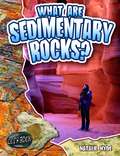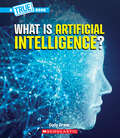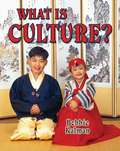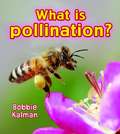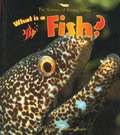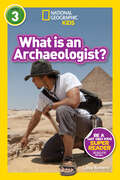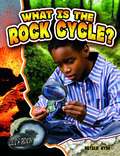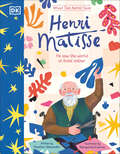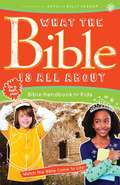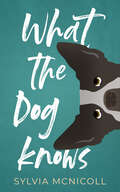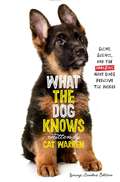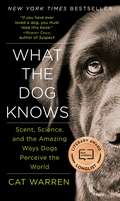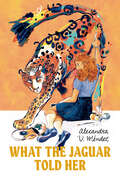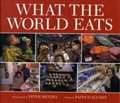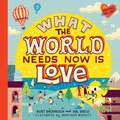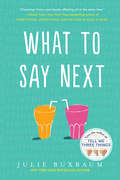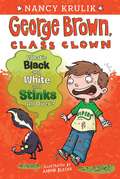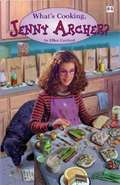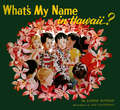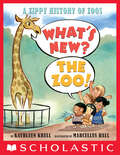- Table View
- List View
What are Sedimentary Rocks?
by Natalie HydeThe science of rocks is fascinating! This rock-solid series looks at the characteristics of different types of rocks-igneous, sedimentary, and metamorphic-describing everything from their mineral components to their color, and whether or not they contain fossils.
What is Artificial Intelligence? (A True Book)
by Cody CraneHow is AI changing our lives? Discover the secrets of this cutting-edge technology with this book for young readers.When people think about artificial intelligence (AI), they may picture a futuristic world of flying cars, robots integrated into the human body, and computers ruling the world. However, AI is already a big part of how we live today-from music apps that let us hear our favorite songs to mapping apps that get us where we need to go. What Is Artificial Intelligence? uses engaging, interactive text to introduce readers to this hot topic, and to teach them how it can be used to improve our lives.ABOUT THIS SERIES:The world of media and technology is changing fast-and young students are right there in the thick of it. As children try to make sense of new technologies, they face a variety of critical issues, including how to access reliable sources of information, how to protect themselves online, and how to use technology in mindful and respectful ways. That's where the books in the Our Digital Future series can help. Each title has been developed to help young readers think critically and navigate new technologies with confidence and care.
What is Culture? (Our Multicultural World Ser.)
by Bobbie KalmanThis title shows our connection to the natural world and to one another. It asks children to put aside their differences and to work together for the common good. What are our common goals? How can we work toward peace, safety, tolerance, and integrity in our lives? How can we live together with respect, kindness and friendship?
What is Pollination? (Big Science Ideas #13)
by Bobbie KalmanPollination by insects is a critical function of all land ecosystems. Most orchard fruits, vegetables, and some field crops are pollinated by insects. This book features photographs that focus on the critical fact that protecting pollinators means having food to eat. It helps children look at insects in a different way. <P><P>Lexile Measure: 830
What is a Fish?
by Bobbie Kalman Allison LarinThis book introduces fishes, showing and describing different types, including freshwater and salt water, and discussing their anatomy, habitats, reproduction, and diet.
What is an Archaeologist? (Readers)
by Libby RomeroIn this Level 3 reader, you can learn all about how archaeologists unearth history, from Egyptian pyramids to Incan roads, and everything in between.Travel around the world and back in time to learn about one of the coolest careers. Discover what archaeologists do, from digging through sand to traversing the jungle to diving into underwater caves. You'll explore exciting discoveries that change our perception of history and check out some of the newest technologies that let us dig deeper into the past than ever before. National Geographic Readers' combination of expert-vetted text, brilliant images, and a fun approach to reading has proved to be a winning formula with kids, parents, and educators. Level 3 text provides accessible yetwide-ranging information for fluent readers. Each reader includes text written by an experienced, skilled children's books author, a photo glossary, and interactive features in which kids get to reinforce what they've learned in the book.
What is the Rock Cycle?
by Natalie HydeThis book talks all about the life cycle of rocks--their origin, types, and other interesting facts.
What the Artist Saw Henri Matisse (What the Artist Saw)
by Heather AlexanderSee the world through Henri Matisse’s eyes and be inspired to produce your own masterpieces.Have you ever wondered exactly what your favorite artists were looking at to make them draw, sculpt, or paint the way they did? In this charming illustrated series of books to keep and collect, you can see what they saw and be inspired to create your own artworks, too. In What the Artist Saw: Henri Matisse, meet the famous French painter and printmaker and learn about his inspiring life and art.A singular look inside the mind of artist Henri Matisse:Follow the life of Henri Matisse and learn about his evolution as an artist, with photographic timelines, informative art reference, and interactive art ideas to try at home yourselfFeatures full-color illustrations that bring the artist’s experiences and creations to lifeA brilliant gift for kids aged 7-9 and young artists who want to learn something new Don’t miss the rest of the What the Artist Saw series!Follow the artists’ stories and find intriguing facts about their environments and key masterpieces. Then see what you can see and make your own art with what you learn. Take a closer look at landscapes, or even yourself, with Vincent van Gogh. Try crafting a story in fabric like Faith Ringgold, or carve a woodblock print at home with Hokusai. Every book in this series is one to treasure and keep – perfect for young artists to explore exhibitions with, then continue their own artistic journeys.
What the Bible Is All About: Bible Handbook for Kids
by Frances BlankenbakerWhat the Bible Is All About Handbook for Kids, based on Dr. Henrietta Mears' classic What the Bible is All About handbook, is a kid friendly, visually exciting resource designed to help children, tweens and younger teens. Children will read and understand Scripture's revelation of God and His great plan of the ages to save the world. Teachers and parents alike will appreciate this resource's appeal to young believers
What the Dog Knows
by Sylvia McNicollNaomi’s dog Diesel returns from the afterlife with one mission — can he save her?It’s Naomi’s worst summer ever. Her dog, Diesel, died. Dad lost his job. Mom and Dad split up. The family is broke, and Naomi is stuck babysitting when she planned to take swimming lessons. Then Naomi’s sometime-friend Morgan convinces her to jump off a dock. On July 1 at precisely 4:30, when Naomi drowns, destiny shifts.Naomi awakes a week earlier to Diesel talking to her. Through his canine counsel, he wants to show her how to fix things. “I can save you,” he barks. But no matter how often Naomi resets her watch, the time and date keep flipping back to July 1 at 4:30, which makes her wonder: Is my time running out?
What the Dog Knows Young Readers Edition: Scent, Science, and the Amazing Ways Dogs Perceive the World
by Cat WarrenIn this young readers edition of the New York Times bestseller, Cat Warren and her canine companion, Solo, teach readers that the nose knows no bounds when it comes to working together, being persistent, and helping others. <P><P>Solo has a fine nose and knows how to use it, but he’s only one of many thousands of scent-detection dogs all over the United States. That’s a group that includes cadaver dogs, tracking, trailing, and apprehension dogs; dogs that can locate unmarked graves of Civil War soldiers; and even dogs that can find drowning victims more than two hundred feet below the surface of a lake. All these dogs love to use their noses. They think their job is simply the best, most interesting game they’ve ever played! <P><P>What good working dogs can do may seem magical or mysterious, but What the Dog Knows shows the science, the rigorous training, and the skilled handling that underlie these amazing abilities.
What the Dog Knows: The Science and Wonder of Working Dogs
by Cat WarrenA firsthand exploration of the extraordinary abilities and surprising, sometimes life-saving talents of “working dogs”—pups who can sniff out drugs, find explosives, even locate the dead—as told through the experiences of a journalist and her intrepid canine companion, which The New York Times calls “a fascinating, deeply reported journey into the…amazing things dogs can do with their noses.”There are thousands of working dogs all over the US and beyond with incredible abilities—they can find missing people, detect drugs and bombs, pinpoint unmarked graves of Civil War soldiers, or even find drowning victims more than two hundred feet below the surface of a lake. These abilities may seem magical or mysterious, but author Cat Warren shows the science, the rigorous training, and the skilled handling that underlie these creatures’ amazing abilities. Cat Warren is a university professor and journalist who had tried everything she could think of to harness her dog Solo’s boundless energy and enthusiasm…until a behavior coach suggested she try training him to be a “working dog.” What started out as a hobby soon became a calling, as Warren was introduced to the hidden universe of dogs who do this essential work and the handlers who train them. Her dog Solo has a fine nose and knows how to use it, but he’s only one of many astounding dogs in a varied field. Warren interviews cognitive psychologists, historians, medical examiners, epidemiologists, and forensic anthropologists, as well as the breeders, trainers, and handlers who work with and rely on these intelligent and adaptable animals daily. Along the way, Warren discovers story after story that prove the capabilities—as well as the very real limits—of working dogs and their human partners. Clear-eyed and unsentimental, Warren explains why our partnership with working dogs is woven into the fabric of society, and why we keep finding new uses for the wonderful noses of our four-legged friends.
What the Jaguar Told Her
by Alexandra V. MéndezJade is starting eighth grade in a new city—Atlanta. She just wants to go back to Chicago, where her friends are. Where her Abuela lives. But Jade does like walking to her new school on the trail that winds through the woods behind her house, where lush flowers bloom and soft leaves rustle beneath her feet. In the forest, Jade feels protected. Sometimes, it's as if it's listening to her. There, Jade meets Itztli, an elderly storyteller who exists between dreams and reality. In the golden afternoons when Itztli appears, he steps out of the forest as a lithe, agile jaguar. But when he speaks to Jade, he is a wise old man who makes intricate works of art and tells her ancestral stories of Mexico. At first, Itztli's stories feel far removed from Jade's life. But as her Abuela suddenly falls ill, two towers come crashing down in New York City, and Jade becomes someone or something she doesn't yet understand, Itztli's stories take on new meaning. Jade must learn to have patience and strength to become who she was always meant to be, as the stirrings of an ancient power awaken within her. What the Jaguar Told Her is a lyrical debut about growing up in the midst of change, and a magical cultural homecoming.
What the World Eats
by Faith D'Aluisio Peter Menzel<P>Sitting down to a daily family meal has long been a tradition for billions of people. But in every corner of the world this age-old custom is rapidly changing. From increased trade between countries to the expansion of global food corporations like Kraft and Nestle, current events are having a tremendous impact on our eating habits. Chances are your supermarket is stocking a variety of international foods, and American fast food chains like McDonald's and Kentucky Fried Chicken are popping up all over the planet. For the first time in history, more people are overfed than underfed. And while some people still have barely enough to eat, others overeat to the point of illness. <P> To find out how mealtime is changing in real homes, authors Peter Menzel and Faith D'Aluisio visited families around the world to observe and photograph what they eat during the course of one week. They joined parents while they shopped at mega grocery stores and outdoor markets, and participated in a feast where a single goat was shared among many families. They watched moms making dinner in kitchens and over cooking fires, and they sat down to eat with twenty-five families in twenty-one countries--if you're keeping track, that's about 525 meals! <P>The foods dished up ranged from hunted seal and spit-roasted guinea pig to U. N. -rationed grains and gallons of Coca-Cola. As Peter and Faith ate and talked with families, they learned firsthand about food consumption around the world and its corresponding causes and effects. The resulting family portraits offer a fascinating glimpse into the cultural similarities and differences served on dinner plates around the globe. <P>[This text is listed as an example that meets Common Core Standards in English language arts in grades 2-3 at http://www.corestandards.org.]
What the World Needs Now Is Love
by Burt Bacharach Hal DavidFor anyone who needs to be reminded of the power of love, this beautiful book is the perfect gift!With its soothing lyrics and calming tones, "What the World Needs Now Is Love" has become a beloved song worldwide since its release in 1965. Now, for the first time ever, these captivating lyrics are in book form accompanied by gorgeous illustrations, and perfectly packaged with a ribbon enclosure.Both a reminder of the importance of love and a call to make the world a better place, this book is the perfect gift for anyone you care about—or for yourself when you need some gentle comfort.
What to Say Next
by Julie Buxbaum<p>From the New York Times bestselling author of <i>Tell Me Three Things</i> comes a charming and poignant story about two struggling teenagers who find an unexpected connection just when they need it most. For fans of Sophie Kinsella, Jennifer Niven, and Rainbow Rowell. <p>Sometimes a new perspective is all that is needed to make sense of the world. <p>KIT: I don’t know why I decide not to sit with Annie and Violet at lunch. It feels like no one here gets what I’m going through. How could they? I don’t even understand. <p>DAVID: In the 622 days I’ve attended Mapleview High, Kit Lowell is the first person to sit at my lunch table. I mean, I’ve never once sat with someone until now. “So your dad is dead,” I say to Kit, because this is a fact I’ve recently learned about her. <p>When an unlikely friendship is sparked between relatively popular Kit Lowell and socially isolated David Drucker, everyone is surprised, most of all Kit and David. Kit appreciates David’s blunt honesty—in fact, she finds it bizarrely refreshing. David welcomes Kit’s attention and her inquisitive nature. When she asks for his help figuring out the how and why of her dad’s tragic car accident, David is all in. But neither of them can predict what they’ll find. Can their friendship survive the truth?
What's Black and White and Stinks All Over? #4
by Nancy Krulik Aaron BlechaGeorge Brown's super burps are causing serious trouble for poor George again. And this time the trouble really stinks! The super burp strikes on Field Day during an outdoor class scavenger hunt. George vows to keep out of any mischief, but he winds up getting skunked. .
What's Cooking, Jenny Archer?
by Ellen ConfordFollows the comic mishaps of Jenny Archer as she goes into business preparing lunches for friends at school.
What's Eating You?: Parasites--the Inside Story
by Nicola DaviesThe creators of Poop and Extreme Animals return with this in-depth look at how parasites--mites, lice, fleas, ticks, and tapeworms--make their homes on (and in) other creatures, including humans. Full color.
What's Faster Than A Speeding Cheetah?
by Robert E. WellsWhat's faster than a cheetah?--no animal on earth can run faster. But a peregrine falcon can swoop faster than a cheetah can run. And the falcon can't compare to an airplane, a rocket, or the speed of light.
What's Faster Than a Speeding Cheetah?
by Robert E WellsWhat's faster than a cheetah?--no animal on earth can run faster. But a peregrine falcon can swoop faster than a cheetah can run. And the falcon can't compare to an airplane, a rocket, or the speed of light. Lively text and watercolors will make children laugh while they learn all about speed.
What's My Name in Hawaii?
by Ray Lanterman Louise BonnerWhat's My Name in Hawaii? is a multicultural children's story of a little Japanese boy's search for a name.He needs a new one because he is about to become an American citizen in Hawaii, where his parents have come to live from faraway Japan.<P><P>When Toshio Takahashi first goes to school he does not want to play with the other children. Like most beginners, he cries because he misses his mother and mostly because he does not speak or understand English. Language, however, proves no barrier in a child's world and soon Toshio is just another flower in the school called Na Lei o Ka Keiki, "a lei of children".When Toshio's citizenship day approaches, all of his young schoolmates wish to help him select an American name like theirs, to add to those reflecting their various racial backgrounds. Susan Iwalani Au suggests "John" and Lisa Ilima Santiago offers "Gaylord" because she has an uncle by that name.The final choice is a happy one for all most of all, to Toshio whose new name now reveals that he was born in Japan, but is an American citizen living in Hawaii, the 50th State of America.
What's New? The Zoo!: A Zippy History of Zoos
by Kathleen KrullWith friendly facts, funny pictures, and animals galore, What's New? The Zoo! is history to roar for!Did you know . . . * The first zoo was established forty-three hundred years ago in what is now Iraq?* Aztec King Moctezuma II had such an incredible collection of animals that it took six hundred men and women to care for them?* Children across Great Britain wrote to Queen Victoria when Jumbo the elephant was sold away from the London Zoo?* Fifty buffalo passed through Grand Central Station in 1907 on their way to the Bronx Zoo?* Zoos now play a crucial role in animal conservation?Kathleen Krull and Marcellus Hall bring witty insight, jazzy style, and a globe-trotting eye to our millennia-long history of keeping animals -- and the ways animals have changed us in turn.
What's Older Than a Giant Tortoise?
by Robert E WellsIf medals were awarded to animals for living a long time, then a giant tortoise would certainly win one. Some giant tortoises have lived for more than 150 years! Still, there are things on this planet much older than giant tortoises. Some of the giant sequoia trees that grow in California would be more than 3,000 years old. But the trees aren't that old compared to the Barringer Crater in Arizona--that was made about 49,000 years ago. And it's almost impossible to imagine that 65 million years ago, the T. rex dinosaur roamed this planet--but we have the skeletons to prove it!
What's Smaller Than a Pygmy Shrew?
by Robert E WellsA pygmy shrew is among the tiniest of mammals. A ladybug is even smaller. But in this book you will find small things you could not ordinarily see.
